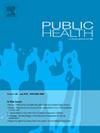探索在健康研究中使用超市忠诚卡数据:范围回顾
IF 3.2
3区 医学
Q1 PUBLIC, ENVIRONMENTAL & OCCUPATIONAL HEALTH
引用次数: 0
摘要
随着会员卡的普及,其在人口健康研究中的作用正在扩大。本研究考察了超市会员卡数据在健康研究中的应用,综合现有文献探讨:(1)所分析的会员卡数据类型,(2)所研究的健康结果,以及(3)会员卡数据的优势和局限性。研究设计:我们使用范围评估来解决研究问题。方法检索MEDLINE、EMBASE、PsycINFO、Scopus 4个电子数据库。如果他们使用大型超市的会员卡数据来调查与健康相关的结果,则研究也被纳入其中。两名研究人员独立筛选研究,提取人口特征、会员卡和产品细节、健康结果以及优势和局限性方面的数据。研究结果采用叙述方法进行综合。结果我们确定了44项使用不同忠诚度计划的研究。大多数研究集中在杂货产品上,根据预先定义的标准(如营养价值)或产品组(如水果和蔬菜)进行分类。健康成果主要涉及饮食和营养问题,有几项研究审查了干预措施和社会人口不平等现象。其他研究评估了对政府活动的反应或追踪了药物使用情况。忠诚度卡的优势包括大规模、客观的数据收集,以及个人、家庭和人口层面的洞察。挑战包括缺少购买活动(例如,不使用卡),难以将购买与营养信息联系起来,以及某些人口群体的代表性过高。结论未来的研究应扩大数据整合(如与健康记录链接),探索新的饮食研究领域,完善分析方法(如概率产品匹配),以最大限度地利用会员卡数据在健康研究中。本文章由计算机程序翻译,如有差异,请以英文原文为准。
Exploring the use of supermarket loyalty card data in health research: A scoping review
Objectives
As loyalty cards gain popularity, their role in population health research is expanding. This scoping review examines the use of supermarket loyalty card data for health research, synthesising existing literature to explore: (1) types of loyalty card data analysed, (2) health outcomes studied, and (3) advantages and limitations of loyalty card data.
Study design
We used a scoping review to address the research questions.
Methods
Four electronic databases (MEDLINE, EMBASE, PsycINFO, and Scopus) were searched. Studies were included if they used loyalty card data from major supermarkets to investigate health-related outcomes. Two researchers independently screened studies, extracting data on population characteristics, loyalty card and product details, health outcomes, and advantages and limitations. Findings were synthesised using a narrative approach.
Results
We identified 44 studies using various loyalty schemes. Most studies focused on grocery products, categorised either by pre-defined criteria (e.g., nutritional value) or product groups (e.g., fruit and vegetables). Health outcomes primarily addressed diet and nutrition, with several studies examining interventions and sociodemographic inequalities. Other studies evaluated responses to government campaigns or tracked medication use. Advantages of loyalty cards included large-scale, objective data collection and individual-, household- and population-level insights. Challenges included missing purchasing activity (e.g., from not using a card), difficulties with linking purchases to nutritional information, and the over-representation of certain demographic groups.
Conclusion
Future research should expand data integration (e.g., linking with health records), explore novel dietary research areas, and refine analytical methodologies (e.g., probabilistic product matching) to maximise the use of loyalty card data in health research.
求助全文
通过发布文献求助,成功后即可免费获取论文全文。
去求助
来源期刊

Public Health
医学-公共卫生、环境卫生与职业卫生
CiteScore
7.60
自引率
0.00%
发文量
280
审稿时长
37 days
期刊介绍:
Public Health is an international, multidisciplinary peer-reviewed journal. It publishes original papers, reviews and short reports on all aspects of the science, philosophy, and practice of public health.
 求助内容:
求助内容: 应助结果提醒方式:
应助结果提醒方式:


